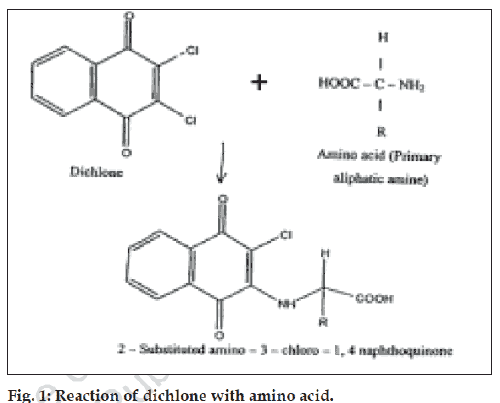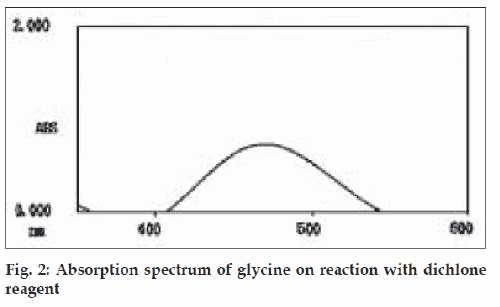- *Corresponding Author:
- S. A. Shah
Department of Quality Assurance, L. M. College of Pharmacy, Navrangpura, Ahmedabad - 380 009, India.
E-mail: shrini_s@hotmail.com
| Date of Submission | 14 March 2005 |
| Date of Revision | 18 January 2006 |
| Date of Acceptance | 15 June 2007 |
| Indian J Pharm Sci 2007, 69 (3): 462-464 |
Abstract
A simple and sensitive colorimetry method has been developed for estimation of amino acids glycine, alanine and isoleucine. Amino acids were derivatized with dichlone in presence of sodium bicarbonate. Amino acids showed maximum absorbance at 470 nm. The method was validated in terms of linearity (5-25 µg/ml for glycine, alanine and isoleucine), precision (intra-day variation 0.13-0.78, 0.22-1.29, 0.58-2.52% and inter-day variation 0.52-2.49, 0.43-3.12, 0.58- 4.48% for glycine, alanine and isoleucine respectively), accuracy (91.43-98.86, 96.26-105.99 and 95.73-104.82 for glycine, alanine and isoleucine respectively), limit of detection (0.6, 1 and 1 µg/ml for glycine, alanine and isoleucine respectively) and limit of quantification (5 µg/ml for glycine, alanine and isoleucine). The method was found to be simple and sensitive.
Amino acids are the structural units of proteins, which are the building blocks of human body and essential component of all living matter. Proteins called enzymes catalyze the chemical reactions fundamental to the life of the cell. Various methods have been reported for analysis of amino acids by spectrophotometry, ß uorimetry, HPLC and HPTLC [1-4]. Most of the amino acids are aliphatic in nature. The aliphatic amino acids lack a chromophore and thus require derivatization in order to detect by UV/Vis detectors. Biuret reagent, Bradford method (coomassie blue G250), Lowry method (Folin Ciocalteau) and ninhydrin reagent are reported for colorimetric method [1,5-6]. The reported method also uses costly reagents like o-phthalaldehyde, phenylisothiocyanate and 2-mercapto ethanol [7-9].
The present study describes development and validation of a simple, sensitive, accurate and precise colorimetry method for estimation of glycine, alanine and isoleucine using dichlone as a reagent, in presence of sodium bicarbonate.
Glycine (S. D. Fine Chemicals, Mumbai) alanine (Fluka AG., Switzerland) and isoleucine (S. D. Fine Chem. Pvt. Ltd., Mumbai) amino acids, sodium bicarbonate and dichlone (2,3-dichloro- 1,4-naphthoquinone) (Samir Tech. Chem Pvt. Ltd), dimethyl sulphoxide (LR., AC’s Chemicals), hydrochloric acid (BP., S. D. Fine Chem. Ltd., Mumbai) and distilled water were used in the study. Double beam Shimadzu 160A UV/Vis spectrophotometer and Shimadzu Libror AEG 220 balance were used during this investigation.
Standard powder of glycine, alanine or isoleucine (125 mg) was weighed accurately and transferred to 25 ml volumetric flask. Sodium bicarbonate (125 mg) was weighed and added to each flask. The contents of flask were dissolved in water to obtain final concentration 5 mg/ml for each amino acid. Dichlone (62.5 mg) was weighed and transferred to 25 ml volumetric flask and dissolved and diluted with dimethyl sulfoxide to obtain final concentration 2.5 mg/ml. Sodium bicarbonate (125 mg) was weighed and dissolved in water to obtain final concentration of 5 mg/ml. Hydrochloric acid (42.5 ml) was diluted to 1000 ml with water to yield 0.5 M solution of acid.
Amino acid solution 0.4 ml was transferred to 100 ml volumetric flask. Sodium bicarbonate solution 0.6 ml and 5 ml of dichlone reagent solution were added. Mixture was heated on boiling water bath (95±2°) for 15 min, cooled to room temperature and volume was made up to 100 ml with hydrochloric acid (0.5 M). Blank was prepared in same manner omitting amino acid solution. Spectrum was scanned on UV/Vis spectrophotometer between 350 to 600 nm. Absorption maxima found was 470 nm.
Amino acid (glycine, alanine or isoleucine) stock solution (0.1, 0.2, 0.3, 0.4 and 0.5 ml) was transferred to a series of 100 ml volumetric flask, and sodium bicarbonate solution (0.9, 0.8, 0.7, 0.6 and 0.5 ml) was added respectively to each flask. Dichlone reagent solution (5 ml) was added to each flask and heated on boiling water bath for 15 min. The solution was allowed to cool to room temperature and volume was adjusted to 100 ml with hydrochloric acid solution (0.5 M). Absorbance of reaction mixture was measured using UV/Vis spectrophotometer at 470 nm against reagent blank. Calibration curve was prepared by plotting absorbance versus its corresponding concentration.
To study effect of the heating time standard solutions of amino acid (0.3 ml) was taken in a series of 100 ml volumetric flask. To each flask 0.7 ml sodium bicarbonate solution and 5 ml of reagent solution was added and the reaction mixture was heated on boiling water bath for different time intervals (0, 5, 10, 15, 20, 25 min). The solutions were cooled to room temperature and diluted up to the mark with 0.5 M hydrochloric acid. The absorbance of the reaction mixture was measured at 470 nm. To study effect of concentration of reagent, standard solutions of amino acid (0.3 ml) was taken in a series of 100 ml volumetric flask and 0.7 ml of sodium bicarbonate solution was added to each flask. Different volumes of reagent solution (3, 4, 5, 6 and 7 ml) were added to the flask and mixed thoroughly. The reaction mixture was heated on boiling water bath for 15 min, cooled to room temperature and diluted up to the mark with hydrochloric acid (0.5 M). The absorbance of the reaction mixture was measured at 470 nm. The method was validated in terms of linearity, accuracy, precision, repeatability of absorbance measurement, limit of detection and limit of quantification.
Dichlone reacts with primary amino group to form orange-colored derivative 2-substituted amino-3- chloro-1,4-naphthoquinone. On basis of this reaction spectrophotometric method [9] was reported for determination of primary aliphatic amines of pharmaceutical interest. Both amines and dichlone were prepared in alcohol. This observation was extended to develop a spectrophotometric method for the estimation of amino acids using dichlone as a reagent (fig. 1). It was observed that on mixing aqueous solution of amino acid in sodium carbonate with dichlone reagent in alcohol, less colour was developed and on dilution dichlone was precipitated out. To overcome this, dichlone reagent was prepared in dimethyl sulphoxide instead of alcohol. Free amino group is necessary for the reaction with dichlone. Therefore amino acids solution was prepared in sodium bicarbonate to get free amino group for the reaction with dichlone.
It was also observed that in alkaline condition amino acid and reagent blank both produce colour. On acidification with hydrochloric acid blank was immediately decolourised while colour of amino acid reaction mixture was remain stable and exhibit wave length of maximum absorbance at 470 nm (fig. 2).
It was found that for maximum color development 5 ml of dichlone reagent ((2.5 mg/ml) and 15 min heating in boiling water bath is must. Molar absorptivity for glycine, alanine and isoleucine was found to be 2.772×104, 2.519×104 and 3.398×104 l/mol cm and Sandell’s sensitivity was 0.0027, 0.0036 and 0.0039 μg/ml/cm2/0.001absorbance unit, respectively. Linearity range for glycine, alanine and isoleucine was found to be in the range of 5 to 25 μg/ml with a correlation coefficient of 0.9979, 0.9960 and 0.9974, respectively. The average linear regression equation for glycine, alanine and isoleucine was represented as Y= 0.0368X-0.0016, Y=0.0289X- 0.0043 and Y=0.0247X+0.0155, respectively, where X is theconcentration of amino acid in μg/ml and Y is absorbance. Accuracy of method was evaluated by calculating recovery of amino acids using standard addition method at 5 levels of the calibration curve (n = 3). The inter-day precision (RSD) was determined for all amino acids in the linear range of 5-25 μg/ml for 5 times over a period of one week. Similarly, the intra-day precision (RSD) was calculated for all amino acids for 5 times on the same day.
Different validation parameters for the proposed colorimetric method are summarized in Table 1.The results indicate that the proposed method was found to be simple, precise and accurate for estimation of glycine, alanine and isoleucine. It can be used in the routine quality control of these amino acids in pharmaceutical industry.
| No. | Parameter | Glycine | Alanine | Isoleucine |
|---|---|---|---|---|
| 1 | Linearity range (µg/ml) | May-25 | May-25 | 5–25 |
| 2 | Correlation coefficient | 0.9979 | 0.996 | 0.9974 |
| 3 | Precision (R.S.D.) Intraday (absorbance) (n=5) (<5%) | 0.13–0.78 | 0.22–1.29 | 0.58–2.52 |
| Interday (absorbance) (n=5) (<5%) | 0.52–2.49 | 0.43–3.12 | 0.58–4.48 | |
| Repeatability of measurement of absorbance (n=7) (<1%) | 0.16 | 0.35 | 0.34 | |
| 4 | % Recovery (n=3) | 91.43-98.86 | 96.26-105.99 | 95.73-104.82 |
| 5 | Limit of detection (µg/ml) | 0.6 | 1 | 1 |
| 6 | Limit of quantification (µg/ml) | 5 | 5 | 5 |
Table 1: Summary of Validation Parameters for Proposed Colorimetry Method
References
- Boffey SA, James AM, Slater RJ, Walker JM. Analysis of amino acids proteins and nucleic acids. 1st ed. Oxford, UK; Butterworth-Heinemann Ltd.: 1992. p. 31.
- Oshite S, Furukawa M, Igarasni S. Homogeneous liquid-liquid extraction method for the selective spectrofluorimetric determination of trace amounts of tryptophan. Analyst 2001;126:703-6.
- Nishi H, Ishii K. New chiral derivatizing reagent for the resolution of amino acids as diastereomers by TLC and HPTLC.Chromatographia 1989;27:301-5.
- Buyuktimkin N, Buschaner A. Separation and determination of some amino acid ester enantiomers by thin-layer chromatography after derivatization with (s)-(+)-naproxen. J Chromatogr 1988;450:281-3.
- Lehninger AL. In: Principles of biochemistry, 2nd ed. CBS Publishers: New York; 1987. p. 95.
- Orten JM. In: Biochemistry, 8th ed. Saint Louis, C.V. Mosby Company - 1970. p. 58.
- Rutan, SC, Motley CB. Factor analysis and Kalman filter studies of severely overlapped amino acid derivatives in Thin Layer Chromatography. Anal Chem 1987;59:2045-50.
- Rawn DJ. Biochemistry, 1sted. New York; Harper and Row Publishers: 1983. p. 33.
- Abou-ouf AA, Taha AM, Saidhom MB. Spectrophotometric analysis of primary aliphatic amines with diclone. J Pharm Sci 1973;62:1700-4.

